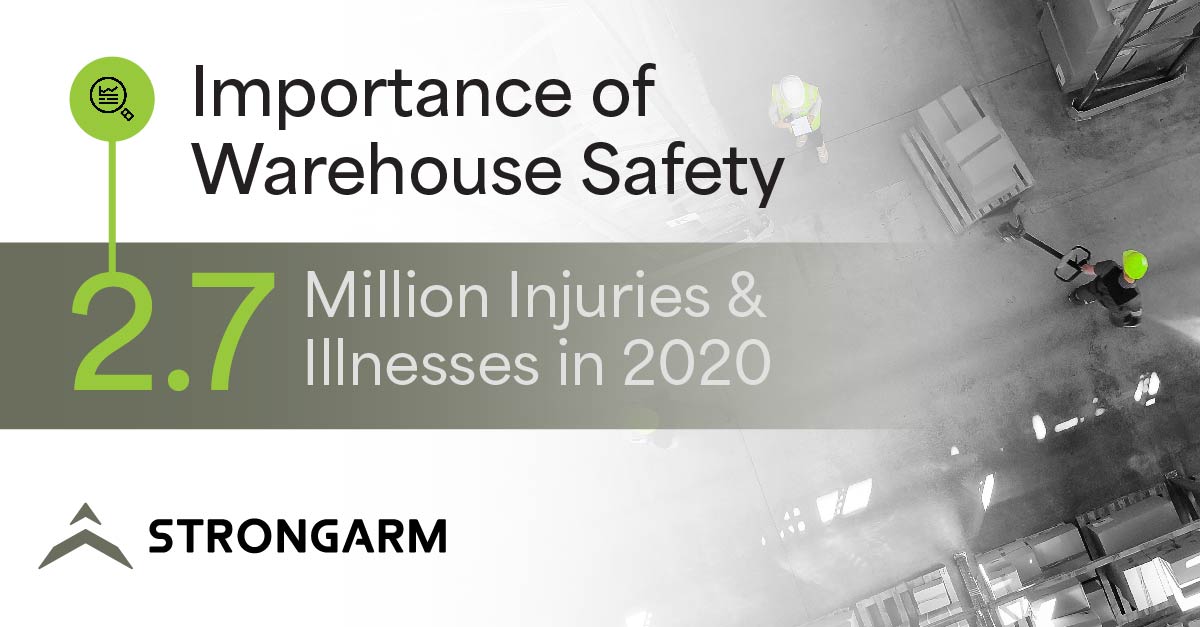How Can You Improve Safety in a Warehouse?
Employees might encounter dangerous situations in the warehouse handling various equipment and goods. Managers need to understand the risk of accidents and what they can do to keep warehouse employees safe throughout the day.
Why Is Warehouse Safety Important?
Warehouse safety procedures and training can help employees and managers understand the dangers of working in a warehouse. Warehouse safety can inspire proactive measures that better protect employees from hazards unique to their industries.
Workplace injuries are common across industries and work environments. In 2020, employers reported 2.7 million nonfatal workplace injuries and illnesses. Further, 2019 reported an all-time high in workplace deaths, with over 5,300 reported deaths. Slips and falls made up many of these deaths, accounting for about 880.
Warehouses have increased hazards because of the various machinery and ergonomic difficulties. Warehouse safety can help reduce the risk of injuries in the workplace, protecting your employees and providing them with a safer work environment.
What Causes Accidents in a Warehouse?
When developing warehouse safety guidelines, it is essential to understand the hazards warehouse employees face every day. Employees who handle various tasks throughout their long shifts experience many risks in the warehouse. Some of the most common warehouse injuries include:
- Poor ergonomic practices: Warehouse employees spend long shifts on their feet lifting and moving heavy objects around storage space. Without the proper care and safety procedures, employees can experience stress injuries, like breaks and strains or overexertion. Injuries can affect specific limbs or hurt parts of the body, like their backs and necks.
- Heat risk: Warehouses can be massive facilities, and due to their scale, temperature can be hard to regulate. During the summer months especially, warehouse temperatures have the potential to rise to dangerous levels, causing employees that do not take proper precautions to be seriously at risk of fatigue, heat stroke, and much more.
- Forklift accidents: Warehouses rely on forklifts to transport and store heavy or oversized items, including pallets organized with goods. However, forklifts can be dangerous for employees and lead to several serious injuries. In 2020, forklift accidents accounted for almost 7,300 injuries that caused employees to miss at least one day of work.
- Insufficient trailer safety: In warehouses where goods are being shipped in or out via tractor trailer, there are risks associated with entering, securing and loading trucks and containers. A lack of systems and protections specifically tailored to trailer safety can lead to injuries.
- Stuck in tight spaces: Warehouses are full of tight spaces — between items, pallets, rows and incoming trucks on the loading docks. Employees face injuries to their extremities — like their fingers and hands — and their entire bodies.
- Slips and falls: Spilled substances and lack of safety equipment can make floors potentially dangerous for employees. Slipping and falling can lead to broken bones and severe strains, causing employees to miss work. Warehouses pose unique threats for falling and slipping with loading docks that have drop-offs several feet tall, increasing the risk and danger of falling.
- Falling objects: Warehouses are where companies store goods for several purposes. However, when goods become loose, they can fall and hit passing employees. Sometimes, entire pallets collapse, making it unsafe for nearby employees. Falling objects vary in weight and height, leading them to cause severe injuries to employees.
- Poor hazardous materials (HazMat) communication: Chemicals can be essential cleaning substances for many businesses, and warehouses often store hazardous materials and use them for sanitary purposes. Additionally, goods being transported through the warehouse may contain hazardous materials. Without the proper signage and communication methods, employees might not understand the risk of handling these products. Mislabelling chemicals or chemicals without labels can lead to chemical burns and other injuries.
- Electrical hazards: Electrical wiring and systems run throughout warehouses to power various processes and equipment. However, when electrical systems don’t meet industry standards, shocks and fires can pose serious threats to warehouse employees.
- Fires: With various power equipment and electrical systems, warehouses are at risk of fires. However, nonportable or inaccessible fire extinguishers and unclear or blocked exits can be fatal or dangerous to warehouse employees.
Knowing the ways your employees can get injured on the job can help managers understand how to protect them.
.png)
How Can You Prevent Warehouse Accidents?
Knowing what you can do to offer comprehensive warehouse safety management can help protect your employees and prevent accidents. Some preventative and protective solutions include:
- Training programs: Lack of knowledge of proper safety procedures can lead to several injuries. Training new employees about how to react in specific situations and protect themselves daily can make them aware of their job’s risks and help them understand what they need to do to stay safe. You can also provide specific training programs for particular positions and tasks, allowing employees to ensure safety when using forklifts or other machinery. It is also helpful to have a central record keeping system of all training provided to each employee so that your company can know who is trained for which processes.
- Signage: Include appropriate visual warnings throughout your warehouse. You might include lines on the floor that mark fall risks on the loading dock or around access points to electrical systems. Signs can help remind employees of potential dangers and give them the chance to take preventative and protective measures while working.
- Chemical labels and data sheets: If your employees handle or store chemicals, provide extensive information on each one. Label each one with the name, manufacturer, potential dangers and any required protective gear when handling it. You can also offer Material Safety Data Sheets (MSDS) for each chemical, including comprehensive information to help employees better understand each chemical they encounter.
- Lockout/Tagout procedures: Lockout/Tagout systems ensure that employees correctly power down equipment and safely store it while it awaits service or maintenance, protecting employees and others from accidentally turning it on. This process creates equipment from starting, physically keeping employees safe using locks and tags.
- Restricted access: Restrict your employees from entering certain areas or using specific equipment without the proper training. For example, employees can only use forklifts if they have received forklift safety training.
- Comprehensive safety equipment: With various hazards throughout the warehouse, you can protect your employees by offering them the right gear for every situation. Give them helmets to protect them against falling objects and gloves when handling chemicals.
- Red Tag & damaged equipment: Implement a system for employees to sideline damaged racking and other equipment so that they do not present a risk to safety. Ensure that you have adequate resources available to fix damaged equipment in a timely manner.
How Can You Improve Warehouse Safety?
While preventative and protective measures can help warehouses reduce injury risks, managers can do more to boost warehouse safety at their locations. Some warehouse safety improvement ideas include:
- Safety culture: When your company values safety, your employees can understand the importance of the issue. Posters with safety reminders can help build a safety culture. However, managers and other executives should frequently address and invest in safety measures.
- Annual comprehensive training: Initial training can ensure employees understand safety measures and importance when they arrive, but they can forget practices. Require employees to take supplementary or annual safety training to remind them how to keep themselves safe.
- Regular inspections and tests: Faulty equipment and protective gear can endanger employees. Testing power equipment to ensure it functions at its best tells you when equipment needs maintenance. Inspecting protective gear can show managers when gloves, helmets, goggles and others need replacing.
These systems can help warehouses improve their safety practices, but enforcement is the most critical factor when implementing protective and preventative procedures. While unsafe practices pose dangers to employees, they are accustomed to doing things differently. Safety enforcement will show your employees you are serious about keeping them safe and the new policies.
Improve Safety in Your Warehouse With the SafeWork System
The SafeWork System from StrongArm Technologies is an excellent tool to help managers keep employees safe while analyzing overall warehouse performance. Employees wear the Bluetooth sensor while they work, and it alerts them when they encounter potential hazards throughout the warehouse. The warehouse wearables send information to a centralized database, allowing managers to use insights to evaluate safety practices.
Warehouse safety requires the right tools. Request a trial from StrongArm Tech today, and discover how we can protect your employees.




